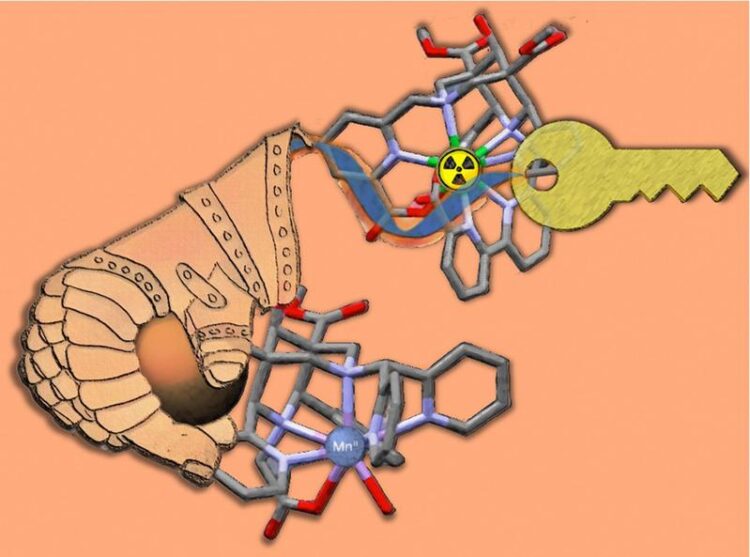Tailor-made metal complexes for medical diagnostics and therapy

Tailor-made metal complexes could be suitable for use in a special way in medical imaging as well as potential applications in personalised precision medicine.
(c) Patrick Arthur Cieslik
Heidelberg chemists study manganese, lutetium, and actinium compounds for potential applications in medicine.
Tailor-made chemical complexes of certain elements from the group of metals could be suitable for use in a special way in medical imaging as well as potential applications in personalised precision medicine. This has been demonstrated by a research team led by Prof. Dr Peter Comba at the Institute of Inorganic Chemistry of Heidelberg University. In their basic research, the Heidelberg scientists worked with manganese, lutetium, and actinium ions. Their work focussed on ligands with a so-called bispidine scaffold. These compounds are extremely rigid and can bind metal ions with great stability and selectivity.
In their work with manganese, a transition metal with special properties such as the ability to boost the contrast in magnetic resonance imaging (MRI), the research team synthesised three different bispidine ligands and their manganese(II) complexes. They exhibit complex stabilities up to ten billion times greater than those of zinc(II), the major competitor of manganese(II) in biological systems. According to Prof. Comba, these compounds are especially well suited as contrast agents in MRI because they do not exchange the manganese ions for zinc ions in animals and humans.
Until now, gadolinium(III) substances were used almost exclusively for this purpose. In recent years, however, safety concerns have increased because free gadolinium(III) ions are toxic, the chemist explains. “This is also true for free manganese(II) ions. However, because manganese, unlike gadolinium, is essential for the human body, there are natural mechanisms that can remove manganese(II) from the body. Further developing these substances for clinical applications can thus be a worthwhile goal,” states Comba. He reports that the quality of initial MRI images in mice with one of the manganese complexes developed in Heidelberg is comparable to the results attained in images with a clinically tested gadolinium contrast agent.
In addition to these new manganese-selective ligands, Dr Patrick Cieslik also developed a bispidine scaffold that forms very stable complexes with the metals lutetium-177 and actinium-225. This ligand is a so-called bifunctional chelator (BFC) with a dual function and is therefore part of a modular system. A BFC can bind with a radioactive metal ion as well as be coupled to a biological vector such as an antibody to detect specific molecules or tissues in the body. In this instance the BFC was coupled to a peptide that can locate tumour cells in the body.
Such a chemical complex – also called a conjugate – can be marked with radionuclides that are important in imaging or treatment. “We were able to demonstrate that our conjugates, with the medically important radionuclides lutetium-177 and actinium-225, exhibit similarly good properties as conjugates with DOTA, a bifunctional chelator already in clinical use,” explains Dr Cieslik, who conducted research for his doctoral thesis in Prof. Comba’s team. “The major advantage of the BFC that we developed is that, unlike DOTA systems, it can be labelled with radioactive metal ions very quickly and under mild conditions. Conjugates can thus be used with very sensitive antibodies that could be relevant for diagnosis and treatment in personalised medicine,” explains Patrick Cieslik.
The research results were published in two papers in the “Journal of the American Chemical Society”. Besides the Heidelberg team, other scientists from Germany and France contributed to the research work. The work was supported by the German Research Foundation and the Max Planck School Matter to Life.
Contact:
Communications and Marketing
Press Office
Phone +49 6221 54-2311
presse@rektorat.uni-heidelberg.de
Contact for scientific information:
Prof. Dr Peter Comba
Institute of Inorganic Chemistry
Phone +49 6221 54-8453
Peter.Comba@aci.uni-heidelberg.de
Original publication:
D. Ndiaye, P. Cieslik, H. Wadepohl, A. Pallier, S. Meme, P. Comba, E. Toth: Mn2+ Bispidine Complex Combining Exceptional Stability, Inertness, and MRI Efficiency, J. Am. Chem. Soc., 2022, 144, 22212-22220. DOI: 10.1021/jacs.2c10108
P. Cieslik, M. Kubeil, K. Zarschler, K. Anger, F. Brandt, M. Ullrich, H. Wadepohl, J. Pietzsch, H. Stephan, P. Comba: Toward personalized medicine: one chelator for imaging and therapy with lutetium-177 and actinium-225, J. Am. Chem. Soc., 2022, 144, 21555-21567. DOI: 10.1021/jacs.2c08438
More information:
https://www.uni-heidelberg.de/fakultaeten/chemgeo/aci/comba/
Media Contact
All latest news from the category: Life Sciences and Chemistry
Articles and reports from the Life Sciences and chemistry area deal with applied and basic research into modern biology, chemistry and human medicine.
Valuable information can be found on a range of life sciences fields including bacteriology, biochemistry, bionics, bioinformatics, biophysics, biotechnology, genetics, geobotany, human biology, marine biology, microbiology, molecular biology, cellular biology, zoology, bioinorganic chemistry, microchemistry and environmental chemistry.
Newest articles

Innovative 3D printed scaffolds offer new hope for bone healing
Researchers at the Institute for Bioengineering of Catalonia have developed novel 3D printed PLA-CaP scaffolds that promote blood vessel formation, ensuring better healing and regeneration of bone tissue. Bone is…

The surprising role of gut infection in Alzheimer’s disease
ASU- and Banner Alzheimer’s Institute-led study implicates link between a common virus and the disease, which travels from the gut to the brain and may be a target for antiviral…

Molecular gardening: New enzymes discovered for protein modification pruning
How deubiquitinases USP53 and USP54 cleave long polyubiquitin chains and how the former is linked to liver disease in children. Deubiquitinases (DUBs) are enzymes used by cells to trim protein…



